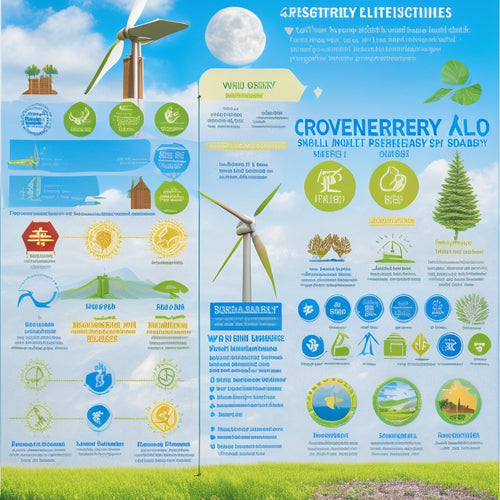
Maximize Your Savings: Residential Solar Incentives Guide
Share
To maximize your savings on residential solar installations, take advantage of multiple incentives. The federal Investment Tax Credit (ITC) allows you to claim 26% of installation costs. States like New York, Arizona, and Florida offer income tax credits and property tax exemptions. Local rebates from utility companies can add up with performance-based incentives. Net metering and trading Solar Renewable Energy Certificates (SRECs) further reduce costs. Also, explore low-interest financing or leasing options to minimize upfront expenses. Group purchase discounts can also provide significant savings. Explore these strategies in detail to fully optimize your solar investment.
Key Takeaways
- Claim the 26% Federal Investment Tax Credit (ITC) for solar installations by 2022 to significantly reduce upfront costs.
- Explore state-specific tax incentives, like New York's property tax exemptions and North Carolina's 35% state tax credit, to further enhance savings.
- Utilize local rebates and utility discounts, including performance-based incentives, to lower overall installation costs and maximize financial benefits.
- Benefit from net metering to reduce electricity bills by earning credits for excess energy produced by your solar system.
- Consider group purchase discounts and community solar initiatives to leverage collective bargaining power for reduced prices and shared renewable energy benefits.
Federal Tax Credits
https://www.youtube.com/watch?v=ZHYfnO1hBNg
One of the most important incentives for residential solar installation is the federal tax credit, which allows you to deduct a substantial percentage of your solar costs from your federal taxes. Specifically, the Investment Tax Credit (ITC) enables you to claim 26% of your installation costs if your system is set up by the end of 2022. This percentage drops to 22% for systems installed in 2023. To qualify, your solar photovoltaic (PV) system must be new and installed on your primary or secondary residence.
Understanding the eligibility criteria is vital. Your solar system must be operational by the end of the tax year, and you must own it outright or through financing—leasing doesn't qualify. Additionally, your tax liability must be sufficient to absorb the credit; otherwise, you may carry it forward to future years.
The application process involves filling out IRS Form 5695, “Residential Energy Credits,” along with your federal tax return. The form requires detailed information about your solar system, including total costs and installation date. Keeping meticulous records and receipts will streamline this process.
State Tax Incentives
In addition to federal incentives, many states offer their own tax incentives to further reduce the cost of residential solar installations. These state incentives can greatly lower both your income tax and property tax obligations, providing you with more financial freedom.
Several states offer income tax credits that allow you to deduct a portion of your solar installation costs from your state income taxes. For example, New York provides a 25% state tax credit, up to $5,000, for residential solar systems. Similarly, South Carolina offers a 25% state tax credit, capped at $35,000 or 50% of the taxpayer's liability for up to 10 years. These credits directly reduce the amount of tax you owe, making solar investments more financially appealing.
When it comes to property taxes, some states have enacted property tax exemptions or abatements for solar installations. For instance, Arizona exempts the added value of a solar system from property taxes, meaning your home's increased value due to the solar installation won't result in higher property tax bills. Similarly, Florida offers a 100% property tax exemption for residential solar installations, ensuring your property tax remains unchanged.
Local Rebates
When considering local rebates, you'll find state-specific solar programs often provide substantial financial incentives.
Utility companies may also offer discounts that can greatly reduce your upfront costs.
Evaluating these options can maximize your savings and improve the overall return on your solar investment.
State-Specific Solar Programs
Understanding state-specific solar programs can uncover substantial local rebates, greatly reducing the overall cost of residential solar installation. Each state offers unique incentives that can greatly lower your financial burden. For instance, state grants often provide direct funding to offset installation expenses.
Investigate regional initiatives that offer additional perks based on your locality.
New York's NY-Sun program, for example, provides substantial state grants and incentives to residents, while California's Solar Initiative encourages widespread adoption through tiered rebates. In Massachusetts, the SMART program provides per-kilowatt-hour payments for solar energy production, directly benefiting homeowners. Additionally, North Carolina offers a 35% state tax credit, making it one of the most lucrative states for solar investments.
Take a methodical approach: start by visiting your state's energy department website for detailed information on available programs. Analyze the eligibility criteria and application processes to make the most of these opportunities. Track deadlines rigorously to make sure you submit on time. Some states also offer performance-based incentives, rewarding higher efficiency and output.
Utility Company Discounts
Utility company discounts, often provided as local rebates, can greatly reduce the cost of your residential solar installation by offering direct financial incentives based on your utility provider's specific programs. These discounts can make a significant impact on your overall investment, making solar energy more accessible and financially liberating.
To take advantage of these discounts, it's important to understand your discount eligibility. Each utility company has specific criteria, which may include factors like your location, energy consumption, and the type of solar system installed. Be sure to check your utility provider's website or contact them directly to verify if you qualify.
Once you've confirmed eligibility, the next step is managing the application process. This typically involves submitting detailed information about your solar installation, including equipment specifications and installation dates. Make sure that your application is thorough and accurate to avoid delays or rejections.
Here are three key steps to maximize your savings with utility company discounts:
-
Research Eligibility Requirements: Know your utility provider's criteria to ensure you qualify.
-
Prepare Documentation: Gather all necessary paperwork before starting the application.
-
Submit Early: Apply as soon as possible to secure available funds before they run out.
Utility Company Programs
Many utility companies offer attractive rebate programs to incentivize residential solar installations. These utility partnerships can greatly reduce your upfront costs and make solar energy more accessible. To maximize your savings, you need to understand your incentive eligibility criteria and the specific programs your utility company offers.
Here's a snapshot of some common utility company programs:
| Program Type | Description |
|---|---|
| Rebate Programs | Cash back for each watt of solar installed. |
| Performance-Based Incentives (PBI) | Payments based on the energy your system produces. |
| Net Metering | Credit for excess electricity sent back to the grid. |
To qualify for these incentives, you'll typically need to meet certain requirements. For example, your solar installation might need to be performed by a certified contractor or your system may have to meet specific performance standards. Detailed research into your local utility's website or contacting their customer service can provide the exact eligibility criteria.
Analyzing these programs helps you determine the best financial strategy for your solar project. By leveraging utility partnerships, you can achieve not only substantial cost savings but also contribute to a more sustainable energy future. Access your potential for energy independence by exploring these utility company programs.
Solar Renewable Energy Certificates
Exploring Solar Renewable Energy Certificates (SRECs), you can further enhance the financial benefits of your residential solar installation by selling these certificates in the energy market. SRECs represent the environmental attributes of your solar power and can be sold separately from the actual electricity generated. This certificate trading can greatly boost your savings.
Understanding the market value of SRECs is important. The value fluctuates based on supply and demand within your state. States with higher renewable energy targets typically offer higher prices for SRECs. By staying informed, you can time your sales to maximize profits.
Here's how you can capitalize on SRECs:
-
Track Production: Monitor your solar system's energy production. Each megawatt-hour (MWh) of electricity you produce earns you one SREC.
-
Market Participation: Participate in SREC markets through brokers or exchanges. They help you trade certificates efficiently and navigate market complexities.
-
Monitor Prices: Keep an eye on SREC prices in your state. Sell your SRECs when market value peaks to maximize returns.
Net Metering Benefits
By utilizing net metering, you can greatly reduce your electricity bills by earning credits for the excess energy your solar panels send back to the grid. This system allows you to accumulate energy credits during peak sunlight hours when your panels produce more electricity than you consume. These credits can then be applied to your account, effectively lowering your monthly energy costs.
Consider a scenario where your solar panels generate 500 kWh of electricity in a month, but your household only uses 400 kWh. The additional 100 kWh is sent back to the grid, and you receive energy credits for this surplus. If your utility company values these credits at $0.10 per kWh, you'd accumulate $10 worth of credits for that month. Over a year, these credits can add up, significantly enhancing your monthly savings.
Data indicates that households with net metering save an average of 20% on their electricity bills. This not only offers immediate financial relief but also empowers you to take control of your energy consumption.
Low-Interest Financing
Securing low-interest financing can substantially reduce the upfront costs of installing residential solar panels, making the investment more accessible and financially viable. By exploring various financing options, you can find a plan that minimizes your initial expenditure while maximizing your long-term savings.
Here's how you can leverage low-interest financing effectively:
-
Assess Loan Eligibility: Begin by checking your credit score and financial history. Many lenders assess your loan eligibility based on these factors. A strong credit profile can open up more favorable interest rates, reducing your overall expenditure.
-
Compare Interest Rates: Interest rates can vary widely between lenders. Analyzing multiple offers allows you to select the most economical option. Even a small difference in interest rates can have a significant impact on the total cost over the loan term.
-
Explore Specialized Solar Loans: Some financial institutions offer loans specifically designed for solar installations. These loans often come with lower interest rates and more flexible terms compared to general-purpose loans, making them an attractive choice.
Solar Lease Options
Many homeowners opt for solar lease options to avoid the substantial upfront costs associated with purchasing solar panels outright. By choosing a solar lease, you can essentially rent the solar equipment for a predetermined period, typically ranging from 10 to 25 years. The contract terms are vital to understand as they outline your obligations and the benefits you'll receive.
Lease durations can vary, and it's important to evaluate which timeframe aligns best with your financial goals. Longer lease durations often result in lower monthly payments but may also include escalator clauses, which can increase payments annually. Conversely, shorter leases might come with higher monthly costs but offer quicker financial benefits.
Detailed analysis of contract terms is indispensable. Look for clauses related to maintenance, repairs, and performance guarantees. These factors can significantly impact your overall savings. Additionally, scrutinize the transferability terms if you plan to sell your home before the lease ends.
Leasing solar panels liberates you from the upfront investment, allowing you to benefit from renewable energy with minimal financial risk. However, the key to maximizing your savings lies in thoroughly understanding and negotiating the lease terms to fit your long-term objectives.
Group Purchase Discounts
Utilizing group purchase discounts can greatly decrease the cost of installing solar panels, as collective bargaining power often leads to lower prices from suppliers. By participating in bulk buying programs, you and your neighbors can leverage community solar initiatives to negotiate reduced rates. This approach not only cuts costs but also fosters a sense of unity and shared commitment to renewable energy.
Here are three key benefits of group purchase discounts:
-
Lower Installation Costs: When multiple households commit to installing solar panels simultaneously, suppliers and installers can offer significant discounts due to economies of scale. This reduction in per-unit cost can make solar energy more accessible.
-
Streamlined Process: Group purchases often come with organized support, including consultations, assessments, and project management. This can simplify the shift to solar power, reducing the time and effort required from each participant.
-
Enhanced Community Engagement: Community solar projects encourage collaboration and collective action. Sharing experiences and knowledge about solar energy with your neighbors can create a stronger, more informed community focused on sustainable living.
Frequently Asked Questions
How Long Does It Take to Install a Residential Solar Panel System?
Did you know 80% of residential solar installations are completed in less than five days? Your installation timeline mainly depends on project duration specifics like system size and roof type, but it's usually a swift process.
What Maintenance Is Required for Residential Solar Panels?
You'll need to clean your solar panels every 6-12 months and check the inverter for dust and debris quarterly. Regular maintenance guarantees peak efficiency and extends the lifespan of your energy-saving investment.
Do Solar Panels Work During Cloudy or Rainy Days?
Imagine a bright day versus a cloudy one. Solar panels still function, though with reduced energy efficiency. Weather impact is significant; panels generate 10-25% of their normal output during overcast or rainy conditions, maintaining some productivity.
How Does Installing Solar Panels Affect My Home's Resale Value?
Installing solar panels can boost your home's resale value due to positive market trends. Buyers appreciate energy savings, which can be a significant selling point. Studies show homes with solar panels often sell faster and at higher prices.
Are There Specific Home Requirements for Solar Panel Installation?
Yes, there are specific home requirements for solar panel installation. Your roof's condition must be solid, and a shading analysis guarantees ideal sunlight exposure. Meeting these criteria maximizes energy production, empowering you with sustainable energy freedom.
Related Posts
-

Evaluating Solar Power Options for Businesses
Evaluating solar power options for your business can greatly reduce energy costs and enhance sustainability. Start by...
-

Energy-Efficient Lighting Solutions for Sustainable Buildings
For sustainable buildings, energy-efficient lighting solutions, like LEDs, offer multiple benefits. These bulbs last ...
-

Renewable Energy Certifications for Businesses
Renewable energy certifications are essential for your business, showcasing your commitment to sustainability and enh...


